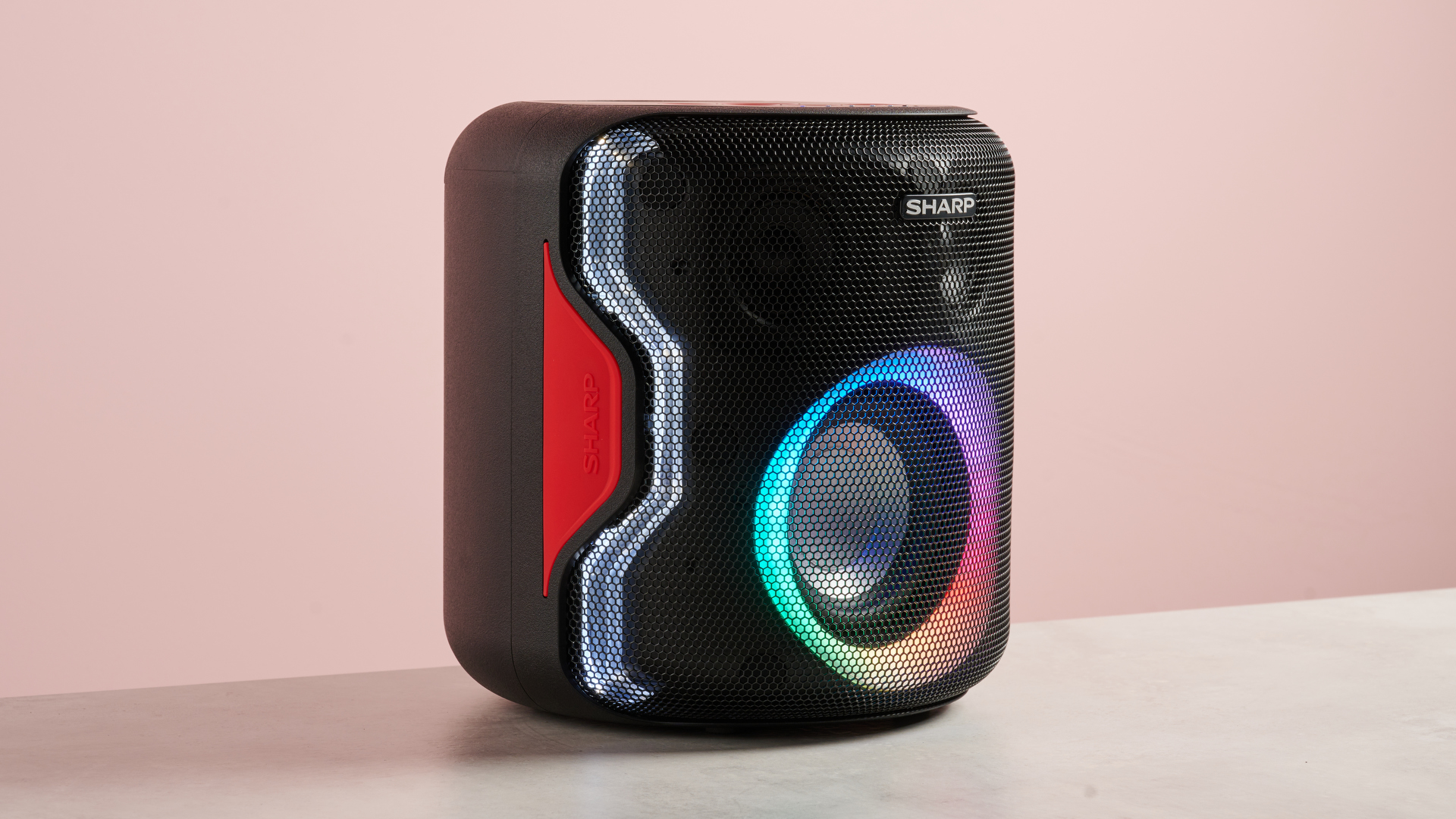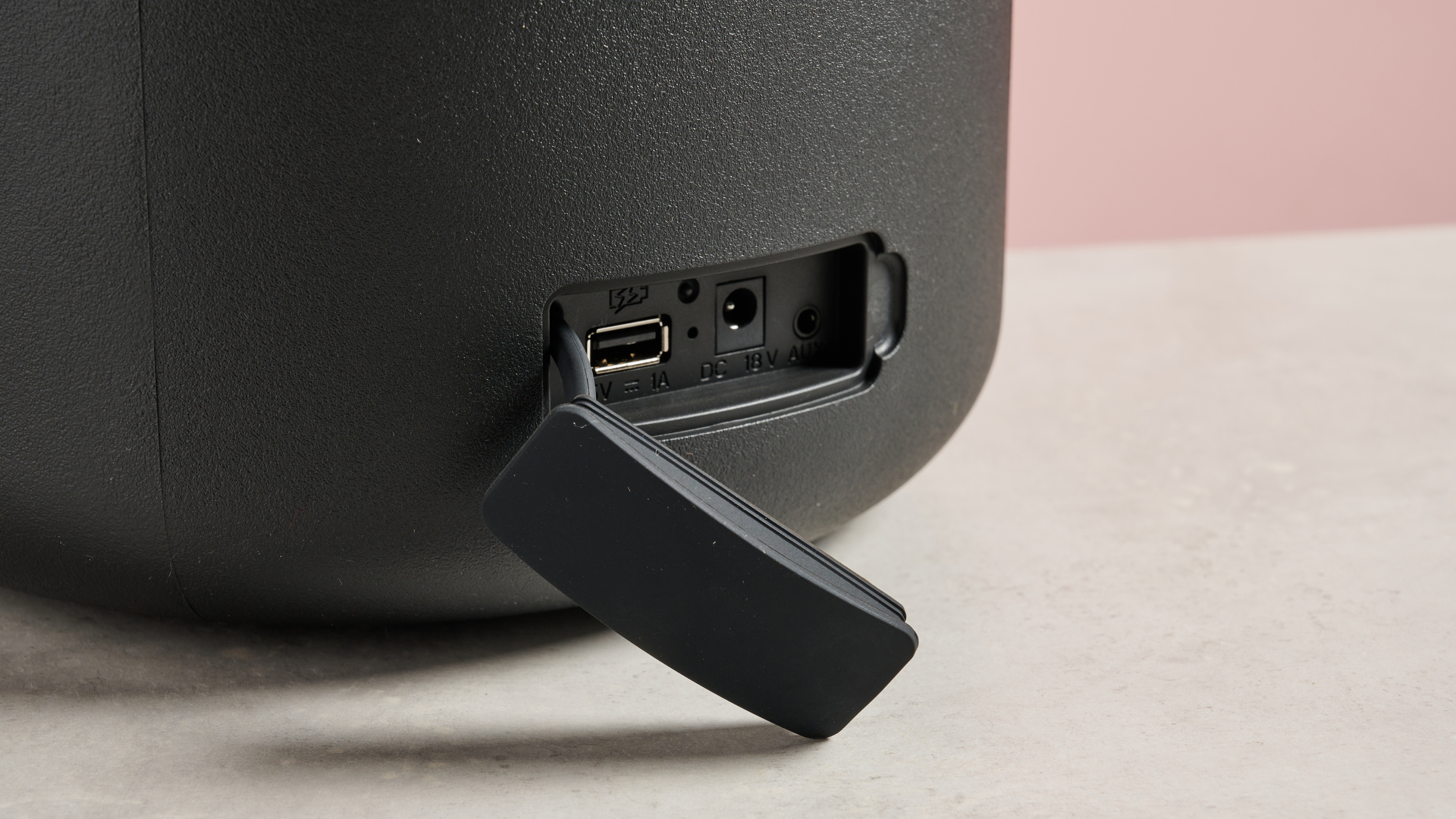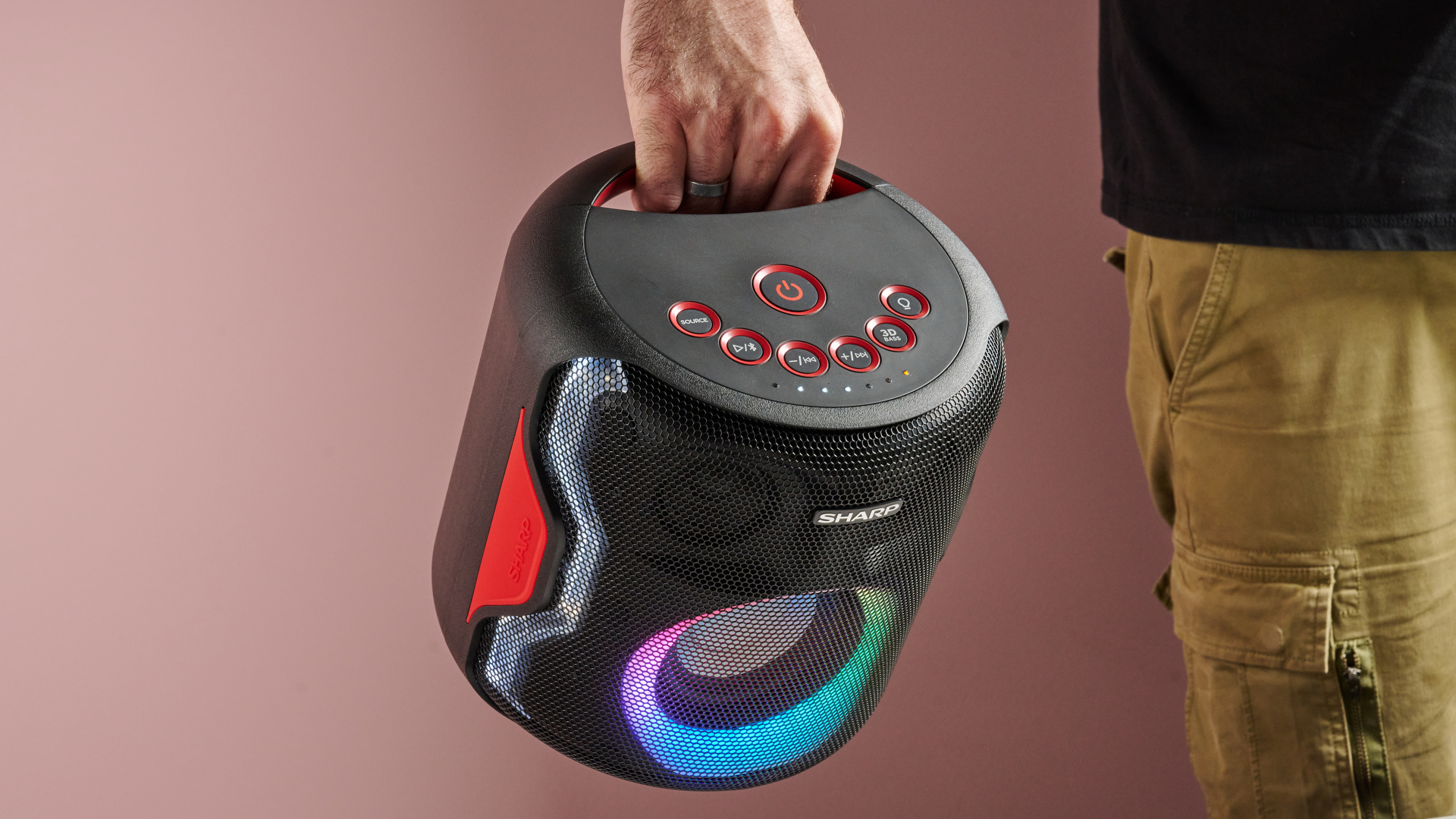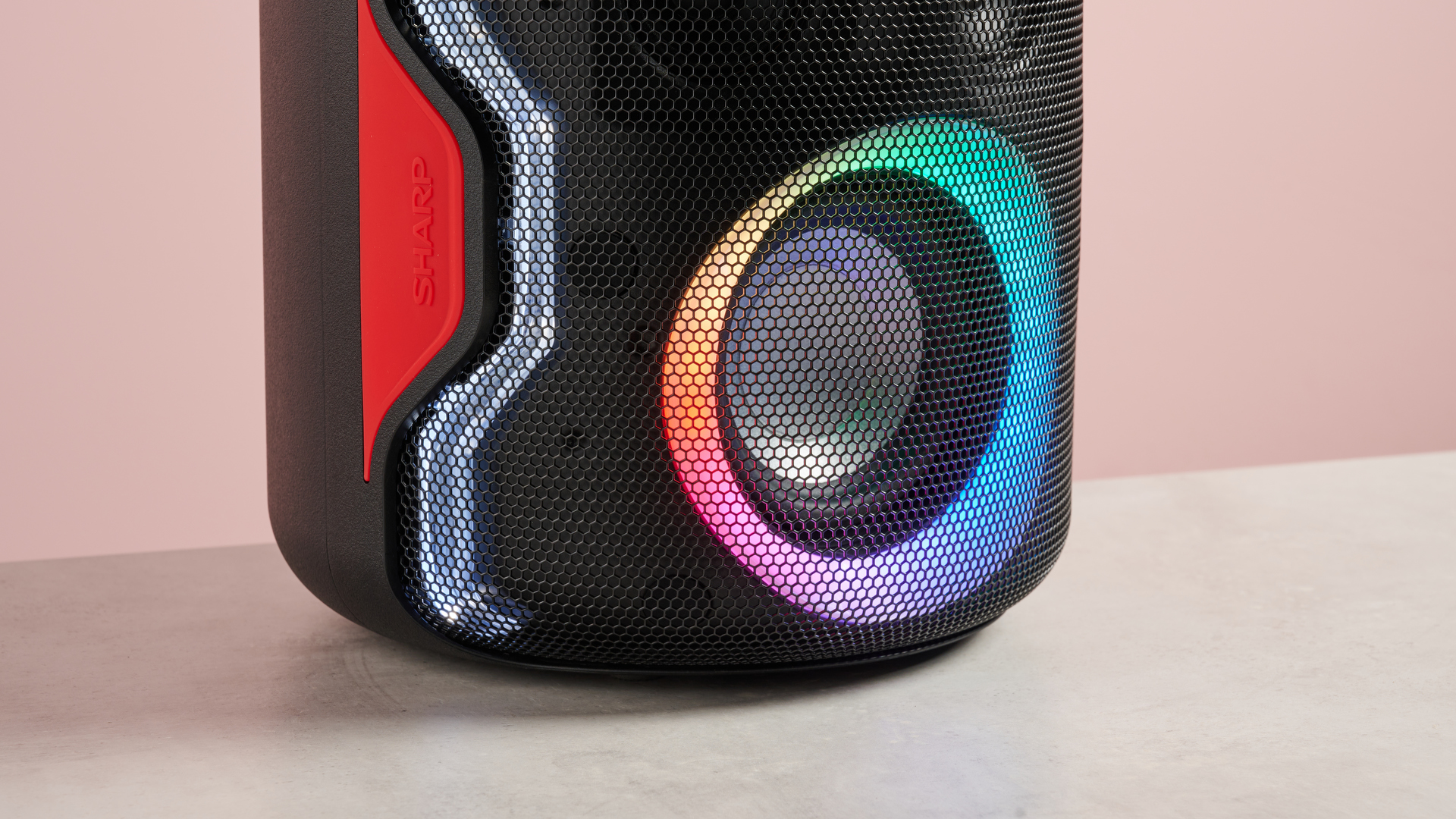
Sharp PS-921: review
The Sharp PS-921 may look a bit like an air fryer, but it’s actually a product vying to be one of the best party speakers we've tested – one that aims to provide imposing, room-filling bass at a modest price. Good news, Sharp (if you’re reading this), I found the PS-921 served its purpose well. It succeeds in delivering bold-sounding bass and the overall audio quality is pretty decent too.
I’ll be clear: the Sharp PS-921 doesn't give you the most elegantly balanced sound, amazing frequency separation, or even generally high-quality audio, but it never claims to be a top-of-the-range hi-res audio phenomenon. This is a party speaker – it has to deliver in just a few key areas, and arguably the most important of these is bass.
In this department, I have to say, it does pretty well. When I tuned into Black Eye by Allie X, the song's explosive, bass-heavy intro came through with impressive depth, impact and clarity. The deep bass of the drum machine, although lacking perfect levels of rapidness, was replicated without noticeable levels of distortion, resulting in a satisfying listening experience.

What really elevates low-frequency sounds, though, is the PS-921’s 3D/Bass feature. This can be set to four configurations: Bass Off, 3D Off; Bass Off, 3D On; Bass On, 3D Off; and Bass On, 3D On. However, it’s crucial that you pick the right setting here, and for me, that was setting 3 (Bass On, 3D Off). I found myself using this mode almost exclusively, as even though low-frequency sounds became more dominant in the overall mix, they didn’t totally overshadow high-frequency ones or get overly muddied with those in the mid-range.
On top of this, 3D mode – which Sharp claims produces “spatial audio” – is underwhelming. You can sense a little bit more breadth from the speaker’s sound output, but bass is lacking in punch and audio clarity is weaker too. Highs turned tinny and unpleasant when listening to Adagio Per Archi E Organo In Sol Minore by the London Philharmonic Orchestra, with the organ sounding particularly grating in this mode.
When combining 3D On and Bass On, the results were pretty bad, with the PS-921 assuming a muddied, confused sound profile. This was a little disappointing but didn’t matter hugely to me, as the combination of Bass On and 3D Off was all I really needed. This configuration showed the PS-921 in its best light and I was grooving to bass-heavy bangers without sensing a destruction of audio clarity or quality. As a result, I used this setting for the vast majority of the testing process.

Although clear, pumping bass is what matters most with party speakers, it’s always nice to get a well-rounded performance. The PS-921 does pretty well beyond bass. For instance, when I tuned in to I Believe in a Thing Called Love by The Darkness, I was satisfied with how it replicated the expansiveness of the track’s multi-layered mix. Sure, I didn’t get to deeply explore all of the song’s sonic intricacies, but I was pleased that the PS-921 had more than just bass to offer.
I also listened to Rains again by Solji to assess the speaker’s performance with treble sounds, and it did, well… alright. I was struck by how rainfall in the track more closely resembled static, and vocals, although palatable, lacked the crisp, sweet sound you’d want to hear. But again, these aren’t massive pain points for a party speaker, especially one that isn’t going to cost you hundreds, like some of the best Bluetooth speakers.
Further to that, Sharp’s speaker performed very well even against one of 2024’s most popular party speakers, the Anker Soundcore Boom 2. Both undoubtedly have a heightened emphasis on low-frequency sounds and, when comparing the two, the Boom 2’s bass – though more powerful – was slightly overbearing. Its overall audio output was generally less clear than the PS-921’s too. For example, when listening to Não Tem Nada Não by Marcos Valle, percussion was quite shrill-sounding from the Boom 2, and although it wasn’t perfect on the PS-921, it was far more controlled and natural. So, as far as overall audio performance goes, the Sharp PS-921 is a very competent party speaker.

One area the PS-921 falls short against its competitors, though, is battery life. Sharp claims that this speaker offers 14 hours of battery life and after seven hours of listening, the speaker hit about 50% charge, so I’d say this is accurate. While 14 hours is, in most cases, enough to easily get you through a party, barbeque or day at the beach, it's considerably less playtime than many rivals offer, with the aforementioned Soundcore Boom 2 boasting a battery life of up to 24 hours. For a speaker of its size, I'd hoped to see the Sharp PS-921 supply playtime closer to 20 hours.
Although it's a pretty modestly priced option, the Sharp PS-921 still lacks a couple of features that other budget Bluetooth speakers offer. The most glaring example is the absence of a companion app. As a result, there’s no way to adjust the speaker’s EQ settings, something I always like to tinker with. Another issue with the lack of an app is you have to change the PS-921’s 3D, Bass mode, and LED light options via unlit button controls – something that might be a bit annoying if you’re in a dark room for a house party or outdoors at night.
That’s not to say the PS-921 is totally devoid of features, however. First, it has multi-colored LED lights around its subwoofer that can be altered – or switched off entirely – via button controls. My favorite was the option to sync the lights to bass output, which highlights the subwoofer bursting as it blasts bass-heavy goodness into the atmosphere.
In addition, the portable speaker has Duo Mode, which enables you to sync it to a second model to form a left and right channel setup. The PS-921’s maximum power is already a strong 130W, so pairing up would be perfect if you’re hosting a mega house party or outdoor event. Finally, the PS-921 has multiple connectivity options: Bluetooth (5.0 + Enhanced Data Rate); USB (for playback and external device charging); and AUX. Although most people will, of course, be using Bluetooth to blast their favorite tunes, the option is a welcome addition.

Despite lacking an app, the PS-921 is still easy to set up and use. When I turned the speaker on I was met with a goofy (in a positive way) didgeridoo sound alongside a voice alerting me that the speaker was on and connecting to my device. From there, it was simple to connect the PS-921 to my phone via Bluetooth.
Although it’s easy to use, this portable speaker doesn’t have the perfect design, in my view. I’ve touched on the LED lights already, and they’re a massive part of the Sharp PS-921’s image. This is a pretty in-your-face, eye-catching Bluetooth speaker but it won't be everyone’s cup of tea. In my opinion, the outer casing’s red highlights clash a bit with the multicolored LED lights, resulting in a slightly convoluted color design. If this is mainly going to be used in dark rooms or outdoor areas for gatherings, this shouldn’t be a massive concern, but if you’re looking for a super sexy, sleek speaker, this isn’t the one.
As I’ve already alluded to, the PS-921 is shaped more like a kitchen appliance than a Bluetooth speaker – it’s quite odd to look at. It’s got a handle on the back that makes it fairly easy to pick up – important as this isn’t exactly one of the lightest portable speakers around – but it's not quite as practical as a handle from a boombox-type design, such as that of the Anker Soundcore Boom 2. However, I was a fan of the button controls, all of which are nicely sized and work well, and the white LED lights on the sides of the speaker look pretty clean too. In terms of practicality, the PS-921 earns some points with its IPX5 waterproof rating, which means it’s perfectly suitable for outdoor use in light rain or placed by the pool.
Look, this thing isn’t the prettiest device and it doesn’t have the most extravagant features, but considering it sets out to be a pure party speaker, the PS-921 is solid. You get clear-sounding booming bass, powerful audio output and even some vibrant LED illuminations (if you’re into that kinda thing). If you’re a student who wants a modestly priced Bluetooth speaker for house parties or someone who wants a portable option for barbecues and outdoor gatherings, the PS-921 is worth considering. Again though, if you’d like a bit more of a feature-rich alternative, however, I’d recommend checking out the options in our guide to the best party speakers.

Sharp PS-921 review: price and release date
- £119.99 (about $150 / AU$240)
- Launched in April 2024
The Sharp PS-921 is priced at £119.99, and I’ve not seen this fluctuate at all since it became available earlier in 2024. This is a good price for a larger budget speaker and is pretty much in line with a lot of competitors. For instance, my point of comparison for this review – the Anker Soundcore Boom 2 – is also typically priced at £119.99.
Sharp PS-921 review: Specs

Should I buy the Sharp PS-921?
Buy it if...
Don't buy it if...
Sharp PS-921: Also consider
Sharp PS-921 review: How I tested

- Tested over the course of two weeks
- Used in the TechRadar music testing room
- Predominantly tested using Tidal on Fiio M11S
I spent hours listening to music on the Sharp PS-921, testing it across its various sound modes and at differing volume levels. I predominantly used the speaker in our music testing room for assessing audio quality and battery testing.
I used Spotify on my Samsung Galaxy Z Flip 4 and Tidal on the Fiio M11S hi-res music player to stream tracks from our carefully curated TechRadar reference playlist. This included songs with pumping deep bass, delicate vocals, and complex mixes, enabling me to test a speaker’s full range and dynamism across different frequencies. I also used the Anker Soundcore Boom 2 as a point of comparison, when appropriate.
- First reviewed: August 2024
- Read more about how we test







